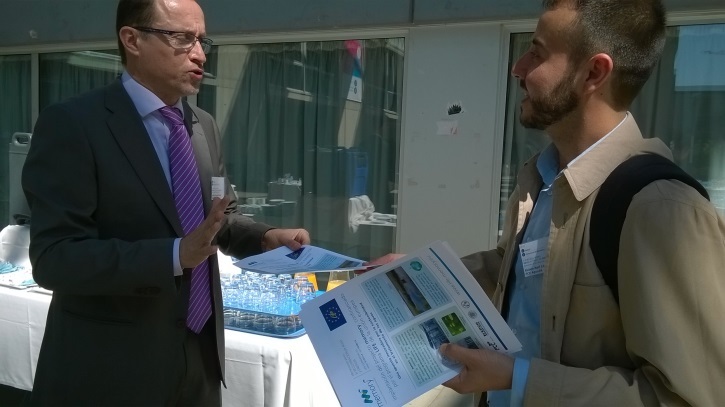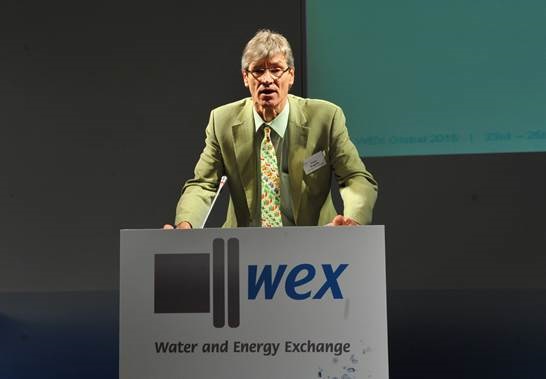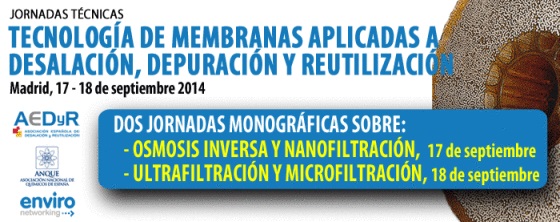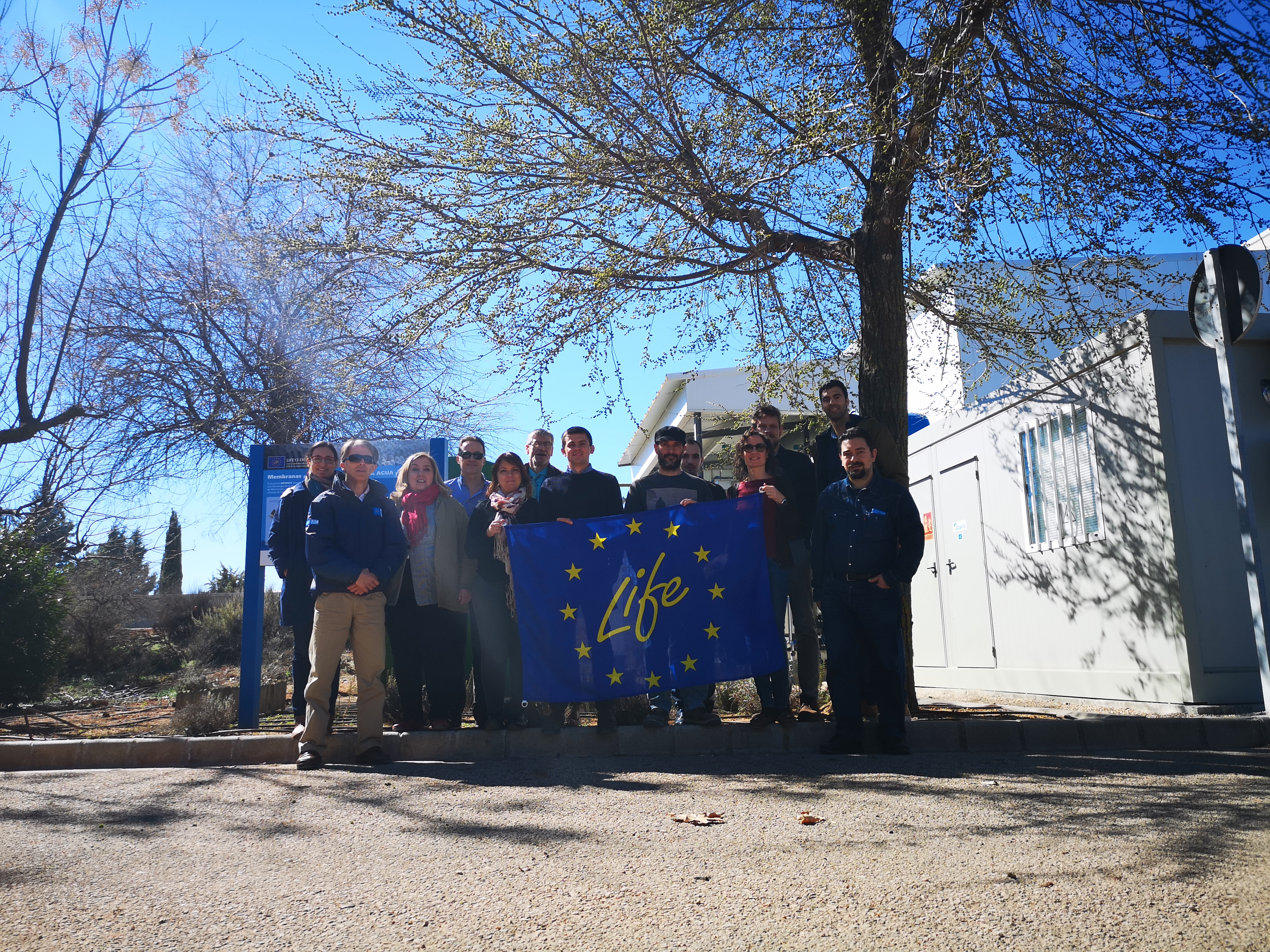-
Life Memory Project
> Communication
> Life Memory Project Communication
>
Newsletter
News:
Anaerobic membrane bioreactors (AnMBR) treating urban wastewater in mild climates (Bioresource Technology)
Expand"Anaerobic membrane bioreactors (AnMBR) treating urban wastewater in mild climates" was published in Bioresource Technology.
Abstract
Feasibility of an AnMBR demonstration plant treating urban wastewater (UWW) at temperatures around 25-30 °C was assessed during a 350-day experimental period. The plant was fed with the effluent from the pre-treatment of a full-scale municipal WWTP, characterized by high COD and sulfate concentrations. Biodegradability of the UWW reached values up to 87%, although a portion of the biodegradable COD was consumed by sulfate reducing organisms. Effluent COD remained below effluent discharge limits, achieving COD removals above 90%. System operation resulted in a reduction of sludge production of 36-58% compared to theoretical aerobic sludge productions. The membranes were operated at gross transmembrane fluxes above 20 LMH maintaining low membrane fouling propensities for more than 250 days without chemical cleaning requirements. Thus, the system resulted in net positive energy productions and GHG emissions around zero. The results obtained confirm the feasibility of UWW treatment in AnMBR under mild and warm climates.
Highlights
• An AnMBR demo-plant was operated during one year under mild climate conditions.
• Effluent COD remained below effluent discharge limits with COD removals above 90%.
• Sludge production was 36-58% lower than theoretical aerobic sludge yield.
• The membranes were operated at gross transmembrane fluxes above 20 LMH.
• A positive net energy production and avoidance of GHG emissions were achieved.
Keywords
PDMS membranes for feasible recovery of dissolved methane from AnMBR effluents (Journal of Membrane Science)
Expand"PDMS membranes for feasible recovery of dissolved methane from AnMBR effluents" was published in Journal of Membrane Science.
Abstract
This study aimed to evaluate the feasibility of degassing membrane (DM) technology for recovering dissolved methane from AnMBR effluents. For that purpose, a PDMS membrane module was operated for treating the effluent from an AnMBR prototype-plant, which treated urban wastewater (UWW) at ambient temperature. Different transmembrane pressures and liquid flow rates were applied for evaluating methane recovery efficiency. Maximum methane recoveries were achieved when increasing the vacuum pressure and reducing the liquid flow rate, reaching a maximum methane recovery efficiency of around 80% at a transmembrane pressure (TMP) of 0.8 bars and a treatment flow rate (QL) of 50 L h−1. The results revealed that the combination of PDMS DMs and AnMBR technology would allow to reduce the energy demand of UWW treatment, achieving net energy productions while reducing greenhouse gas emissions. Optimum operation was determined at a TMP of 0.8 bars and a QL of 150 L h−1 when combining energy, environmental and economic targets. Under these operating conditions, the combination AnMBR + DM resulted in energy requirements and greenhouse gases emissions of −0.040 kWh and 0.113 kg of CO2-eq per m3 of treated water, respectively, resulting in a DM payback period of around 10.5 years.
Highlights
• PDMS membranes allow a suitable methane capture from AnMBR effluents.
• AnMBR energy efficiency can be improved by employing PDMS membranes.
• Greener wastewater treatments can be reached by coupling PDMS membranes with AnMBR.
• PDMS membranes showed a feasible potential for full-scale applications.
Keywords
8 November, 2018. EurEau Annual Congress Limassol (Limassol, Cyprus)
ExpandEurEau Annual Congress Limassol where was presented the Life Memory Project: “Boosting circular economy in sewage treatment”.
23 September, 2018. 1st Workshop of the 11th International Conference on Urban Drainage Modeling (Palermo, Italy)
Expand1st Workshop of the 11th International Conference on Urban Drainage Modeling where was presented the Life Memory Project: “State-of-the-art MBR-based technology for anaerobic wastewater treatment: Identifying key issues for AnMBR modelling”.
16 - 21 September, 2018. IWA World Water Congress & Exhibition (Tokyo, Japan)
ExpandIWA World Water Congress & Exhibition where was presented the Life Memory Project: “AnMBR Technology: Boosting circular economy in sewage treatment”.
9 - 13 July, 2018. Euromembrane 2018 (Valencia, Spain)
ExpandEuromembrane 2018 where was presented the Life Memory Project in the Oral presentation titled: “Optimising membrane performance for anaerobic urban wastewater treatment”.
25 - 27 June, 2018. IWA Specialized International Conferences on Ecotechnologies for Wastewater Treatment (ecoSTP) (London, Ontario, Canada)
ExpandIWA Specialized International Conferences on Ecotechnologies for Wastewater Treatment (ecoSTP) where was presented the Life Memory Project: “Environmental behavior of an AnMBR demo plant for sewage treatment: the LIFE MEMORY Project”.
18 - 20 June, 2018. XIII Spanish Roundtable on Water Treatment (META) (León, Spain)
ExpandXIII Spanish Roundtable on Water Treatment (META) where a poster with important information about Life Memory Project was presented: “Proyecto LIFE Memory: Mejorando la sostenibilidad en el tratamiento del agua residual urbana”.
14 June, 2018. Water & The Circular Economy Conference (Liverpool, The U.K.)
ExpandWater & The Circular Economy Conference where was presented the Life Memory Project: “Biofuel production and sustainable wastewater treatment”.
12 June, 2018. WWT Water Industry Energy Conference 2018 (Birmingham, The U.K.)
ExpandWWT Water Industry Energy Conference 2018 (Birmingham) where was presented the oral presentation titled: “From waste to riches: The business benefits of energy from waste”, where Life Memory project was included.
21 November, 2017. Encontro Nacional de Entidades Gestoras de Água e Saneamento - ENEG 2017 (Évora, Portugal)
ExpandEncontro Nacional de Entidades Gestoras de Água e Saneamento (ENEG 2017) where was presented the Life Memory Project: “AnMBR Technology: Boosting circular economy in sewage treatment”.
20 October, 2017. 15th IWA World Conference on Anaerobic Digestion – AD-15 (Beijing, China)
Expand15th IWA World Conference on Anaerobic Digestion – AD-15 (Beijing, China) where was presented an oral presentation of Life Memory tittled “Scaling up of AnMBR technology: moving from wastewater to source of resources”
29 September, 2017. European Innovation Partnership (EIP) Water Conference 2017 (Oporto)
ExpandEuropean Innovation Partnership (EIP) Water Conference 2017 (Oporto), where the Area Manager José Vázquez presented the oral presentation “Curving the line to accelerated resource recovery: The Life Memory, INCOVER and RUN4LIFE projects, and a closer look at resource recovery factories”.

8 September, 2017. 8th IWA Membrane Technology Conference & Exhibition for Water and Wastewater Treatment and Reuse (Singapore)
Expand8th IWA Membrane Technology Conference & Exhibition for Water and Wastewater Treatment and Reuse (Singapore), where the Aqualia R&D department presented “Optimising the filtration process in AnMBR technology for sewage treatment”.
21 June, 2017. Water Technology and Environmental Control Exhibition & Conference (WATEC Italy 2017, Palermo)
ExpandWater Technology and Environmental Control Exhibition & Conference (WATEC Italy 2017, Palermo), where José Vázquez presented: “LIFE Memory. Anaerobic Membrane Bioreactor: curving the line towards circular economy”.
15 June, 2017. Workshop “Membranes for water treatment and reuse” (Girona)
ExpandWorkshop “Membranes for water treatment and reuse” (Girona), where the project technical manager, Freddy Durán presented during the elevator pitches section the LIFE MEMORY Project.
14 June, 2017. VI Conference of Membrane Bioreactors (Barcelona)
ExpandVI Conference of Membrane Bioreactors (Barcelona), where the project technical manager, Freddy Durán presented “Life Memory Project: Towards the waste water treatment of the XXI century. (http://www.ub.edu/bioamb/brm/programa.html).
11 - 14 June, 2017. 12th IWA Specialized Conference on Instrumentation, Control and Automation (ICA2017, Quebec, Canada)
Expand12th IWA Specialized Conference on Instrumentation, Control and Automation (ICA2017, Quebec, Canada) where was presented the poster “ICA of an anaerobic MBR (AnMBR) industrial prototype plant for urban wastewater treatment”.
28 February - 3 March, 2017. 1st Innovative Solutions for Water Management Forum. Explanation of Life Memory among other R&D projects at the speaker's corner in Madrid
Expand1st Innovative Solutions for Water Management Forum. Explanation of Life Memory among other R&D projects at the speaker's corner in Madrid

17 November, 2016. IWATER trade held (Barcelona)
ExpandThe AnMBR technology and the LIFE MEMORY project were presented by the R&D department of Aqualia at the IWATER trade held in Barcelona.
3 November, 2016. Technical conference of EPSAR (Public Water Entity of Valencia). Presentation of Life Memory results
ExpandPresentation of LIFE MEMORY results in the technical conference of New technologies applied to the Wastewater Treatment Sector, organized by EPSAR (Public Water Entity of Valencia).
27 September, 2016. iAgua Magazine #12 presentation. Discussion about current models of wastewater reuse
ExpandiAgua Magazine #12 presentation. Discussion about current models of wastewater reuse.
27 - 30 June, 2016. European projects of Aqualia are disseminated in ecoSTP 2016
ExpandEUROPEAN PROJECTS OF AQUALIA ARE DISSEMINATED IN ECOSTP 2016
In Cambridge, was organized the 3rd IWA Specialized International Conference Ecotechnologies for Wastewater Treatment (ecoSTP 2016).
Frank Rogalla, Director of Innovation and Technology department, presented the project "LIFE MEMORY".

Links of interest:
http://www.ecostp2016.com/index.html
29 February - 2 March, 2016. Aqualia renews its commitment to the innovation with the participation in the X Conference WEX Global celebrated in Lisbon
ExpandAQUALIA RENEWS ITS COMMITMENT TO THE INNOVATION WITH THE PARTICIPATION IN THE X CONFERENCE WEX GLOBAL CELEBRATED IN LISBON (PORTUGAL)
One more year Aqualia has had the opportunity of participate in the WEX Global conference celebrated last February 2016 in Lisbon, Portugal.
This edition has been celebrated under the title " Water, Energy & an End to Waste: Winning Strategies for the Resource Revolution". Aqualia’s participation was included in the session titled “Membrane Technology Enabler of the Resource Revolution” in which the objectives, expected results and progress of MEMORY project were described.


Links of interest:
http://wex-global.com/wp-content/uploads/2016/02/A4-programme-february-no-hours-no-days-1.pdf
15 - 18 November, 2015. European projects of Aqualia are disseminated in Chile
ExpandEUROPEAN PROJECTS OF AQUALIA ARE DISSEMINATED IN CHILE
The Chilean city of Viña del Mar has hosted the 14th World Congress on Anaerobic Digestion organized by the IWA, following the successful 13th edition in 2013 that was held in Santiago de Compostela (Spain) with Aqualia as the main sponsor. Success has now repeated across the Atlantic with more than 700 attendees from universities and companies around the world, and was inaugurated by Marcelo Mena Carrasco, Secretary of the Ministry of Environment of Chile.
Aqualia was represented by different members of the Department of Innovation and Technology and represented an important role, thanks to the research financed by the European Union, and selected for oral presentation at the event.


Links of interest:
7 - 10 June, 2015. Innovative ideas that go around the World
ExpandINNOVATIVE IDEAS THAT GO AROUND THE WORLD
Organized by the WEF (Water Environment Federation) in Washington DC, there have been celebrated two events: the Conference on residuals and biosolids and the Congress on water and energy. More than 1,500 people gathered to discuss how to avoid residuals production and maximize recovery of resources from wastewater.
Aqualia has had an outstanding participation, including the coordination of a workshop about the generation of biomethane with anaerobic membrane reactors, which will be shown in the Life Memory project.

Links of interest:
28 May, 2015. V Conference of Membrane Bioreactors
ExpandV CONFERENCE OF MEMBRANE BIOREACTORS
PROCITEC, with the support of University of Barcelona, organized the V Conference of Membrane Bioreactors in Barcelona on May 28th.
The event provided an excellent opportunity for the meeting of the main protagonists of the wastewater treatment sector and, most especially, those responsible for the design and operation of this type of membrane bioreactors and treatments.
Aqualia, represented by Ruben Reif, showed the objectives and progress of MEMORY project, which was kicked off in July 2014.



Links of interest:
- http://www.ub.edu/bioamb/brm/index1.htm
- http://www.aguasresiduales.info/revista/noticias/los-biorreactores-de-membrana-anaerobios-tema-central-en-de-la-v-jornada-sobre-biorre-3WhXI?utm_source=Procitec+1&utm_campaign=1bd3858356-ULTIMO+MAILING+BRM+2015&utm_medium=email&utm_term=0_bb28422732-1bd3858356-
23 - 25 February, 2015. Technological and innovative solutions of FCC Aqualia, protagonists in the WEX 2015 conference
ExpandTECHNOLOGICAL AND INNOVATIVE SOLUTIONS OF FCC AQUALIA, PROTAGONISTS IN THE WEX 2015 CONFERENCE
Last February 2015 has taken place in Istambul IX conference of WEX Global, a landmark event in matters of water and energy.
This edition has been celebrated under the title "Water, Energy and the Zero Waste Society" and Aqualia has had a notable participation.
Jointly with Koch Membrane Systems, and within the panel "Wastewater Treatment, Membrane Technology and Water Reuse", Frank Rogalla, Director of Innovation and Technology department, presented the project "LIFE MEMORY".

Links of interest:
- http://wex-global.com/
- http://www.iagua.es/noticias/turquia/fcc-aqualia/15/02/27/soluciones-tecnologicas-y-innovacion-fcc-aqualia-protagonistas
- http://www.aguasresiduales.info/revista/noticias/las-soluciones-innovadoras-de-fcc-aqualia-en-el-campo-de-tecnologico-y-de-innovacion--mFL7i
- http://www.retema.es/actualidad/fcc-aqualia-lleva-sus-ltimas-soluciones-en-el-campo-tecnolgico-y-de-innovacin-a-wex-global-2015
4 - 5 November, 2014. Highly interactive EIP Water Conference 2014 conclude in Barcelona
ExpandHIGHLY INTERACTIVE EIP WATER CONFERENCE 2014 CONCLUDED IN BARCELONA
The European Innovation Partnership on Water has taken a central role on the European water innovation landscape, providing a platform for all actors in the field of water and innovation. After the success of the first EIP Water conference in November 2013 in Brussels, the second EIP Water annual Conference took place on 5 November in Barcelona, the European Innovation Capital 2014.
As leader of the Action group AG036 ("Anaerobic Membrane Bioreactor for Recovery of Energy and Resources"), University of Valencia participated in the event where over 400 attendees participated in enlightening discussions on connecting water innovation demand and supply, learned about the activities of 25 EIP Water Action Groups, identified opportunities for collaboration and helped shape European water innovation policy.


Links of interest:
http://www.eip-water.eu/events/highly-interactive-eip-water-conference-2014-concluded-barcelona
7 October, 2014. The large company bets on LIFE projects
ExpandTHE LARGE COMPANY BETS ON LIFE PROJECTS
For the first time, large companies are interested in the European LIFE funding line, so far typical of SMEs, universities, research centers, public administrations, ...
During the call of 2013, large companies have shown interest and in the beneficiaries list there are firms like Aqualia, Iberdrola or Acciona.


Links of interest:
http://diario.eleconomista.es/i/393421-eleconomista-agua-y-medioambiente-07-octubre-2014?token
17 - 18 September, 2014 Membrane technology applied to desalination, purification and reuse
ExpandMEMBRANE TECHNOLOGY APPLIED TO DESALINATION, PURIFICATION AND REUSE
Aqualia had the opportunity to participate in the I monographic conference about Membrane Technology organized by AEDyR (Asociación Española de Desalación y Reutilizacion). The aim of the conference was an update of the status of membrane technology from the points of view of manufacturers, users and researchers.
In his intervention, Ruben Reif, presented the projects of Aqualia in which membrane technology is the focus of the process. One the most important project about membrane technology, which Aqualia leads, is the LIFE MEMORY project.


Links of interest:
Meetings:
Next 27 February, 2019. Project Visit, Alcázar de San Juan
ExpandPROJECT VISIT, ALCÁZAR DE SAN JUAN
The European Comission visited the Life Memory Project on February 27th.


30 October, 2018. Technical meeting, Valencia and Madrid
ExpandTECHNICAL MEETING, VALENCIA AND MADRID
On October 30th at the University of Valencia, a meeting has taken place where the last advances in the project have been summarized and the next efforts planned. Attendants: Aurora Seco (UV), Joaquín Serralta (UPV), Angel Robles (UV), Antonio Jimenez (UPV) and Ana Ruiz (UPV) present, Frank Rogalla (Aqualia) contacted by telephone.
7 June, 2018. Neemo visit, Madrid
Expand4RD NEEMO VISIT, ALCÁZAR DE SAN JUAN
This meeting between the consortium of the LIFE MEMORY project and Neemo was organized to:
- Review of the status of the actions’ implementation
- Remind the required activities in terms of dissemination and present their status
- Check administrative and financial aspects


15 February, 2018. Technical meeting, Alcázar de San Juan
ExpandTECHNICAL MEETING, ALCÁZAR DE SAN JUAN

30 January, 2018. Technical meeting, Valencia
ExpandTECHNICAL MEETING, VALENCIA
22 May, 2017. Neemo visit, Madrid
Expand3RD NEEMO VISIT, MADRID
This meeting between the consortium of the LIFE MEMORY project and Neemo was organized to:
- Review of the status of the actions’ implementation
- Remind the required activities in terms of dissemination and present their status
- Check administrative and financial aspects
At the end, it was also time for the partners to have technical discussions.


4 October, 2016. Technical meeting, Alcázar de San Juan
ExpandTECHNICAL MEETING, ALCÁZAR DE SAN JUAN


31 May, 2016. Neemo visit, Madrid and Alcázar de San Juan
Expand2ND NEEMO VISIT, MADRID AND ALCÁZAR DE SAN JUAN
This meeting between the consortium of the LIFE MEMORY project and Neemo was organized to:
- Review the status of the implementation of the project’s technical actions
- Remind the required activities in terms of dissemination and present their status
- Check administrative and financial aspects
- Visit prototype in construction and implementation site
This was also the occasion for the partners to have technical discussions.



30 March, 2016. Consortium meeting, Madrid
ExpandCONSORTIUM MEETING, MADRID

28 January, 2015. Technical meeting, Alcázar de San Juan
ExpandTECHNICAL MEETING, ALCÁZAR DE SAN JUAN
After an introduction from the plant manager), a visit to the Alcazar WWTP premises was conducted. The visit focused on the units that are not currently being operated (phase 1 of the plant), to assess the possibility of using them for supporting the prototype implementation. Two main possibilities were considered: use of a settler for the anaerobic reactor and/or the use of the pretreatment tank for equalization. The first option might not be realistic, since the cost of the works for conditioning and fixing the unit might be excessive.On the other hand, it was considered feasible to use the pretreatment tank. The space availability for the prototype was also checked. An area adjacent to the pretreatment was found adequate.
20 January, 2015. Neemo visit, Madrid
ExpandNEEMO VISIT, MADRID
This meeting between the consortium of the LIFE MEMORY project and Neemo was organized to:
- Introduce Neemo’s role in the project monitoring
- Review the status of the implementation of the project’s technical actions
- Remind the required activities in terms of dissemination and present their status
- Check administrative and financial aspects.
This was also the occasion for the partners to have technical discussions and to launch the Inception Report process.

15 October, 2014. Technical meeting, Valencia
ExpandTECHNICAL MEETING, VALENCIA
The meeting was focused on discuss the selection of the demonstration site and the design of the demonstration plant:
Update on the different sites available for project´s implementation, focusing on two main options: Tortosa (Tarragona) and Alcázar de San Juan (Ciudad Real). Some characterization data from the wastewater treated in Tortosa WWTP is available. The ratio between COD and sulfate is around 10 (average values of COD: 600 mg/L and SO42-: 180 mg SO4/l). These values might be valid for SAnMBR operation. However, there are not enough SO42- measurements to confirm this trend. Other feasible option is the Alcazar de San Juan WWTP, but sulphate content might be higher and a more complete set of characterization data is necessary. The main advantage of this location is the possibility to treat wastewater originated from industries (apart from the domestic input) discharging with higher COD values (helpful to equilibrate the ratio). However, winter temperatures are expected to be low on this location, which might be challenging particularly for the start-up period of the SAnMBR. A heating system might overcome this issue during specific operational periods. Other options such as a golf course in Madrid were discussed, but more time is necessary to confirm the availability of this option in the short term.
UV and UPV provide a first process flow diagram of the plant. It is agreed that the design will consider the use of a 60 m3 container for the anaerobic reactor with the aim of easily transporting the plant. In case the dimensions of the anaerobic reactor don´t fit within the standard container, a possibility might be to place the container in vertical.
The preliminary diagram does not include the rotofilter and the equalization tank, but it is expected to include them in the final design.
Other agreements for the design of the prototype were:
- Reaching a total volume (including head-space) no lower than 30 m3 (first proposal in the project summary was 7 m3). Considering the availability of membrane surface area, the PURON modules from Koch will be operated simultaneously to reach the desired values of hydraulic retention time and transmembrane flux. For routine maintenance (physical or chemical cleaning of the membranes), one of the modules can be stopped (operation expected to be carried out no more than twice a year).
- A second container will be used to store the rest of the instruments and equipment, apart from the Anaerobic Reactor and membrane tanks (pumps, blowers, automatization devices, etc.). In case there is not enough space availability, the methane recovery system, the CHP (combined heat and power system) and the pretreatment can be stored outside the containers.
- The anaerobic reactor will be equipped with diffusers in the bottom to recycle biogas (for mixed liquor stirring) and to test a microaireation strategy to upgrade biogas quality.
- Regarding the recovery of dissolved methane from the permeate, the project proposal considers an air-stripping process. However, and with the aim to increase the security of the process, the use of pervaporating membranes is strongly suggested.
- It was proposed to test different membrane units for the project. A feasible option is a Microdyn membrane module, which is already available. This membrane provides a total surface area of 50 m2, adequate for the dimensions of the LIFE MEMORY prototype.
29 July, 2014. Technical meeting, Valencia july
ExpandTECHNICAL MEETING, VALENCIA JULY
Discussion on the first sites found available for project´s implementation. UV and UPV prefer a location close to Valencia to optimize travel costs (expected visit frequency should be 3-5 days a week due to frequent laboratory analysis). Since it´s necessary to consider different criteria (wastewater characteristics, plant availability to host staff from the project, space availability, feasibility to reuse produced effluent, etc.), more sites are being surveyed. In case the final selection is far away from Valencia, FCC Aqualia staff from the Innovation and Technology Department will take care of most of the samples analysis in the laboratory of the selected premise following UV/UPV instructions. Extra analysis will be done periodically by UV at their premises for confirmation and quality control. FCC Aqualia will manage samples shipment and UV will support analysis with fungible material, visiting the demonstration site regularly.
The supervision of the operation, simulations and control of the prototype will be in charge of UV/UPV, being a task carried out from the Universities facilities, in order to minimize travel costs. FCC Aqualia staff will be in charge of plant operation on a daily basis.
11 July, 2014. Kick off meeting, Madrid
ExpandKICK-OFF MEETING, MADRID
This meeting was organized to officially kick off the Project Management for the LIFE+ project LIFE MEMORY. Themes that were discussed during the meeting were:
- Present the persons involved in the project
- Review the project objectives and milestones
- Explain the eligibility rules and which accounting measures need to be implemented
- Discuss the budget and the involvement of each partner
- Discuss the first version of the Partnership Agreement
XXI century: From wastewater to Resource Source
Towards a new paradigm based on sustainability, where wastewater now turns into a source of energy, nutrients and simultaneously, a water resource suitable for reuse.
In this context, LIFE MEMORY project targets for the sustainable production of reusable water demonstrating the feasibility of an innovative technology: the Submerged Anaerobic Membrane Bioreactor (SAnMBR).




